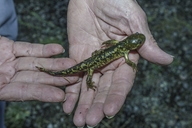|
Ambystoma mavortium Baird, 1850
Barred Tiger Salamander, Gray Barred Tiger Salamander, Blotched Tiger Salamander, Arizona Tiger Salamander, Sonora Tiger Salamander Subgenus: Heterotriton | family: Ambystomatidae genus: Ambystoma |
| Species Description: Baird, S. F. (1850 "1849"). Revision of the North American tailed-batrachia, with descriptions of new genera and species [Including: Descriptions of four new species of North American salamanders, and one new species of scink, pp. 292–294]. Journal of the Academy of Natural Sciences of Philadelphia. Series 2(1), 281–294. | |
|
Taxonomic Notes: This taxon is often considered a subspecies of A. tigrinum. We treat it as a full species, including taxa recognized by others as subspecies of A. tigrinum (except for A. tigrinum tigrinum). |
|
 Gerald and Buff Corsi © 2021 California Academy of Sciences (1 of 53) |
|
|
|
Description Distribution and Habitat Country distribution from AmphibiaWeb's database: Canada, United States U.S. state distribution from AmphibiaWeb's database: Arizona, California, Colorado, Idaho, Kansas, Minnesota, Montana, North Dakota, Nebraska, New Mexico, Nevada, Oklahoma, Oregon, South Dakota, Texas, Utah, Washington, Wyoming Canadian province distribution from AmphibiaWeb's database: Alberta, British Columbia, Manitoba, Saskatchewan
Habitat is diverse - it includes bottom land deciduous forests, coniferous forests and woodlands, open fields and bushy areas, alpine and subalpine meadow, grasslands, semideserts and deserts, and (rarely) in streams. Sandy or friable soils make for good breeding ground. Life History, Abundance, Activity, and Special Behaviors Larva Trends and Threats Relation to Humans Comments The species epithet, "mavortium" is a reference to the Roman god Mars, "Mavortial" or “warlike”(Tighe 2023). This species was featured as News of the Week on 26 December 2022: The evolution of chemical alarm cues has been puzzling to evolutionary biologists. At first glance, the cues appear to only help other individuals, not the preyed-upon individual that produced and released the cues (the 'sender'). However, according to theory, the evolution of communication systems requires benefits to senders. Releasing alarm cues can benefit the sender’s genes by warning their nearby kin, but prey often do not associate based on kinship. There is some evidence that alarm cues can protect against certain parasites and pathogens. However, an alternative hypothesis is that alarm cues attract additional predators to an attack, thereby interfering with it, and allows the prey to escape. This is known as the 'Predator Attraction Hypothesis'. Previous studies on fishes have provided support for this hypothesis, but amphibians had not been tested before. Crane et al. (2022) used Tiger salamander (Ambystoma mavortium) larvae (predators) and Wood Frog (Rana sylvatica) tadpoles (prey) to test this hypothesis and found the predators were attracted to alarm cues. This was even more apparent when the salamanders had prior experience with tadpole prey. When two salamanders were present, they rushed their attacks and were less accurate than when alone. This increased the chances of escape for tadpoles. We also found that the mere presence of visual and chemical cues from a second salamander caused enough of a distraction to increase tadpole survival. All together, their results support the Predator Attraction Hypothesis for the evolution of chemical alarm cues in tadpoles. (Written by Adam Crane)
References
Harte, J., and Hoffman, E. (1989). ''Possible effects of acid deposition on a Rocky Mountain population of the tiger salamander Ambystoma tigrinum.'' Conservation Biology, 3, 9. Irschick, D.J. and Shaffer, H.B. (1997). ''The polytypic species revisited: Morphological differentiation among tiger salamanders (Ambystoma tigrinum) (Amphibia: Caudata).'' Herpetologica, 53(1), 30-49. Petranka, J. W. (1998). Salamanders of the United States and Canada. Smithsonian Institution Press, Washington D.C. and London. Tighe, K.A. (2023). Catalog of type specimens of recent Caudata and Gymnophiona in the National Museum of Natural History, Smithsonian Institution. Smithsonian Contributions to Zoology 654. Originally submitted by: Brian Petirs (first posted 2001-10-30) Edited by: Vance T. Vredenburg, Michelle S. Koo (2023-08-11) Species Account Citation: AmphibiaWeb 2023 Ambystoma mavortium: Barred Tiger Salamander <https://amphibiaweb.org/species/5887> University of California, Berkeley, CA, USA. Accessed Apr 25, 2024.
Feedback or comments about this page.
Citation: AmphibiaWeb. 2024. <https://amphibiaweb.org> University of California, Berkeley, CA, USA. Accessed 25 Apr 2024. AmphibiaWeb's policy on data use. |



 Raffaëlli Account
Raffaëlli Account Map of Life
Map of Life